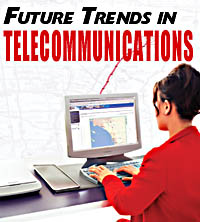
A flood of mobile and telecommunications devices has hit the PHCP industry in recent years. Increased use of broadband and wireless connections has spurred on the market for new devices that are hands-free, capture and transport videos and utilize voice recognition. How will the market handle the security and management issues that come with this phenomenon?

Wireless Saturation And Security
There is no doubt wireless technology has prodded the advent of new capabilities in mobile devices. “Up to this point, the way we've been looking at and interacting with the wireless market is penetration,” says Alan Marcus, vice president of wireless infrastructure at Symbol Technologies, a provider of mobile computing products including advanced data capture products, radio frequency identification technology and wireless infrastructure. “We think in 2006, we see it moving from that penetration to more saturation.”The trend may be moving toward mesh networking, Marcus says. Rather than utilizing localized hot spots to gain wireless access, mesh networking creates hot zones with building-wide or campus-wide coverage or even hot regions that span an entire metropolitan area. Basic WiFi (Wireless Fidelity) untethers the user, whereas mesh networking untethers the entire network from the need for a wired connection. The concept is comparable to the Internet, which itself operates as a gigantic mesh that can largely self-manage and configure itself. Large warehouses, auditoriums and standard office spaces with a lot of cubicles will start using this type of fully wireless network.
“We're definitely interested in not only the mesh,” Marcus says, “but what it may represent in the future.” For one, it simplifies technology.
“Most of the time I walk into a facility and see six or seven outlets, but which one connects to my network?” asks Marcus. Wireless eliminates that confusion.
The movement of wireless will start to include radio-frequency identification (RFID), an inevitable trend in the supply chain. With the multitude of data exchanged between the supplier and the distributor and the retailer, RFID users are going to be looking at how the networks are organized to handle all that data, says Marcus.
Going wireless with it is even more problematic, he says, because if it's not done properly, the user won't receive the advantages of the RFID and wireless capabilities. An open hole in the network could mean lost data. If businesses can start using wireless networks now and work out all the kinks, the implementation of RFID and the collection and dissemination of the data that goes with it will be much smoother.
The Technology, Media & Telecommunications group of Deloitte, a research firm, identified security in connected technologies as one of the top 10 trends for 2005. The report stated the increased use of mobile phones, remote networking and WiFi will allow for more harmful intrusions such as viruses, worms and malware - unauthorized malicious actions, VoIP (Voice over Internet Protocol) SPAM and blue-jacking - attacks on Bluetooth-enabled devices, which use a radio chip to connect and transmit data to other devices. Market saturation means users don't just have the wireless access, but that it is their primary access - making information and data much more vulnerable. Security strategies to watch for include:
- Authentication - monitoring who's allowed on to the network,
Encryption - encoding data,
Intrusion protection - policing unauthorized users from getting onto the network,
Policy engine - defining the rules, including what users can do and where they can access the network, for the network environment.
Even more sophisticated are biometrics security measures, such as retinal scans. Something like this wouldn't even require password protection since it's difficult to spoof a retina. While far-off sounding, this is already being used in the Amsterdam airport for passport control.
“We're going to see physical and IT security coming together,” Marcus says. For instance, most companies use a badge to unlock a door. In the future, a small watch-style key or an employee's PDA (Personal Digital Assistant) may grant access to the secure area.
Flood Of Devices
Research and development sectors are constantly looking at ways to improve the current mobile computing products. They're looking at voice recognition, wearable products that allow for hands-free usage, RFID, and cameras within the devices. But a new trend is: how will managers keep track of all of these tools? They will need a platform to keep the software and information updated on all of the remote users' devices, says Brian Viscount, vice president of mobile computing at Symbol Technologies. Say you have five sales representatives using a PDA, a management platform allows a manager to look at each remote device, update the software and see if it's working properly.The convergence of voice and data capabilities into one device is another upcoming trend. Personal Digital Assistants are beginning to take what is at workers' desks - documents, e-mail and telephone calls through a VoIP connection - and putting it in their hands outside of the confines of the workplace. These devices may even add on other capabilities, such as bar code scanning and data capture. “There is no doubt that voice and data are coming together,” says Viscount.
Increased use of broadband and fiber-optic Internet connections in homes and businesses is helping to spur on the technological advancements in telecommunications devices. Users will increasingly be able to create, upload and download literature and videos to and from Web sites faster, says Viscount. His company is looking at adding imaging to their digital assistants to allow users to take videos.
GPS Technology Becomes Commonplace
While GPS (Global Positioning Satellite) technology has been around since the 1980s, when it was employed by the U.S. government, companies began utilizing it in the '90s for commercial use and only recently has it become viable for small business use. Currently only about 5% of fleet vehicles use the technology, says Dave Dutch, president of Networkcar, which provides GPS fleet management devices. However, within two or three years, 30-40% of all fleet vehicles will employ it. It used to be something that only a large trucking company carrying millions of dollars of cargo could afford. Now, Dutch says, his company has a client so small it only manages four vehicles.It allows the company to constantly monitor its vehicles, as well as provide good customer service. “Landmarking” allows the user to find the closest vehicles to a service area.
The future of this technology, though, lies in real-time information transmission through Web development, Dutch says. The devices will act as more of an onboard computer that transmits exact location, mileage, driver's speed and vehicle diagnostic information. Eventually they may even track specific vehicle problems, such as informing the user when the alternator is about to go bad, says Dutch. This would allow for easier long-term maintenance.
Virtual Warehouse
“I remember 10 years ago people telling me there would only be just-in-time delivery,” says Steve Millett, thought leader of Battelle - a technology research laboratory. He predicts there will always be warehouses, but a lot of the processes will continue to become virtual. Millett gave the example of Amazon, which he at first thought would only be a middleman for deliverers and buyers. But time was at a premium, and the company needed to host warehouses to gain control and monitor responsiveness. If someone could come up with a way to virtually meet that time demand, it would advance, but that is “many, many years” down the line, he says.
As for manufacturing, it will all shift to allow bar coding down to the component level. “We're going to have a tremendous amount of information to back quality control,” Millett says. “We'll be able to detect why it failed and where it failed.”
Home To The Workplace
When a technology is commonplace in the home, it's a good indicator it is available and being used by businesses small and large. Millett identified the following advancements in consumer telecommunications:Convergence: “I think the most important trend is the convergence of telecommunications with information technologies,” he says. Telephone companies are offering Internet access and phone providers are offering cable. The Internet and the computer are also starting to converge, and will shift dramatically as consumers buy more flat panel screens and high-definition televisions. Homes used to have just one television and one telephone. They are already starting to have multiples of everything - televisions, computers and phones - and people will have many options both at home and when traveling.
Teleconferencing in the home: Businesses have been doing this for years, but the prices on the technologies will come down, and people will be able to see each other over the computer or the television. “The big driver in that is going to be families,” says Millett. Family members around the world want that connection.
Voice activation: Think of Star Trek, where actors talked to the computers and they talked back. Computerized demands in the future may allow us to talk to our appliances and tell them to turn on and off.
Cell phones: Internet access on cell phones is to become increasingly common in the next five years.
GPS as a tracking device: “We talked about GPS as early as 1995 as a future strategic technology,” Millett says. It could not only be used for navigation, but also to track individuals. The security outweighs the privacy issues, Millett says, as Alzheimer's patients or young children could be easily monitored. “Certainly in 10 years, it's possible for all of us to be tracked as we travel.”
